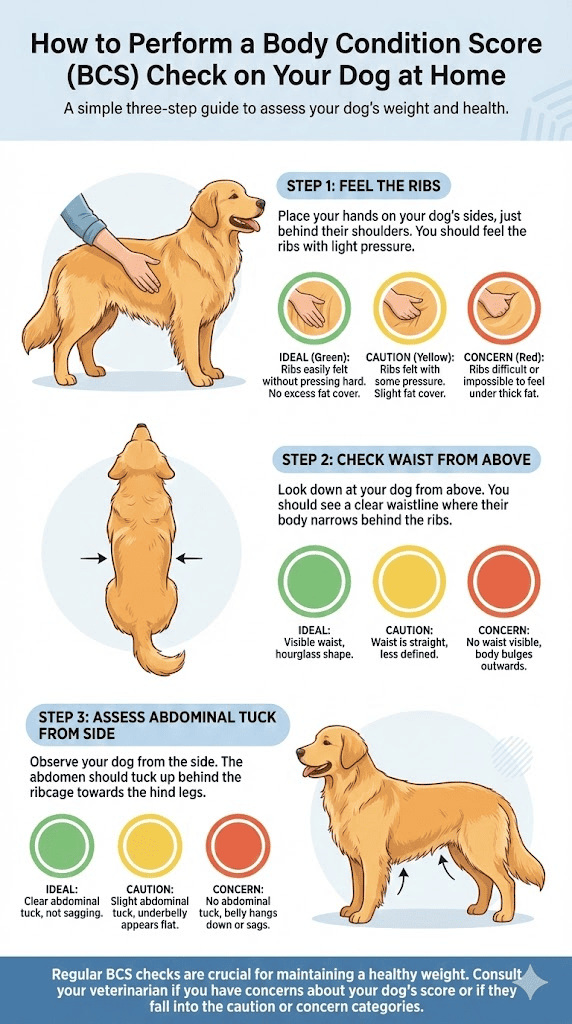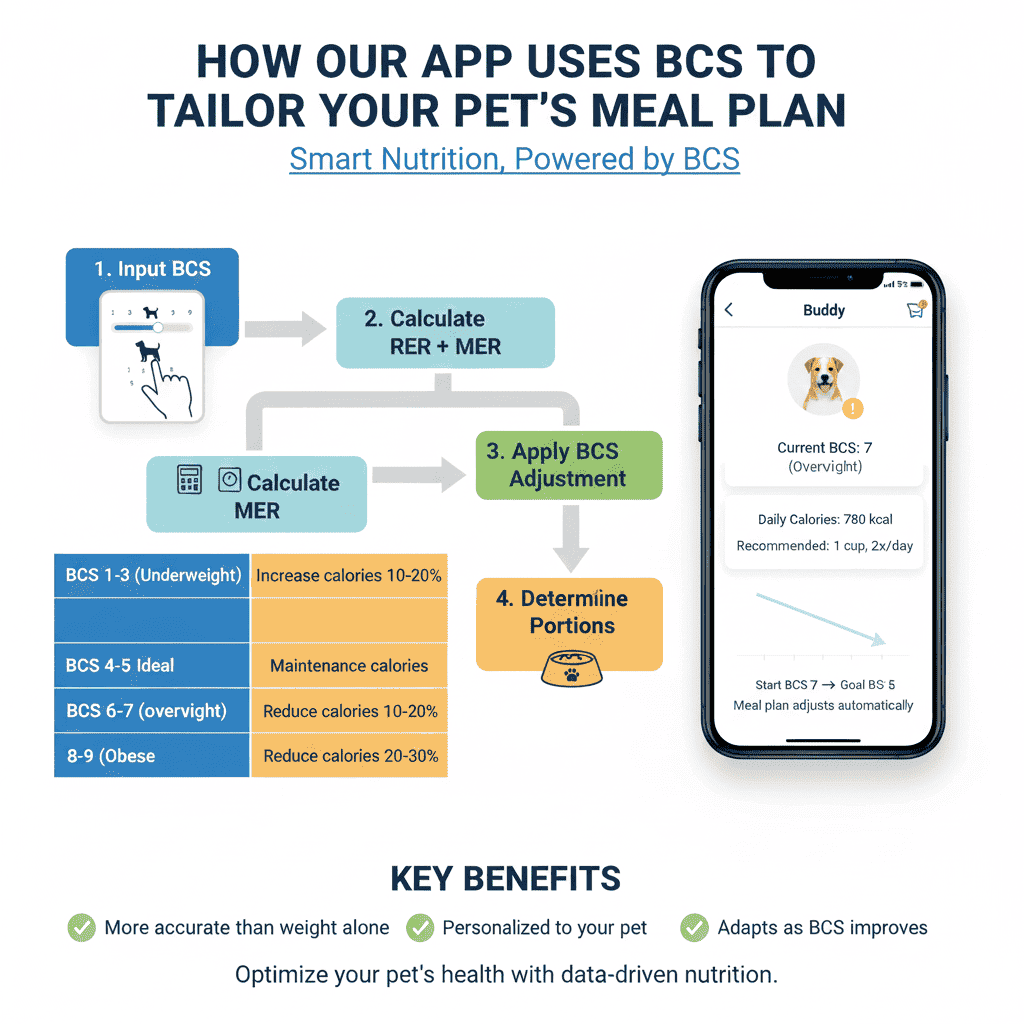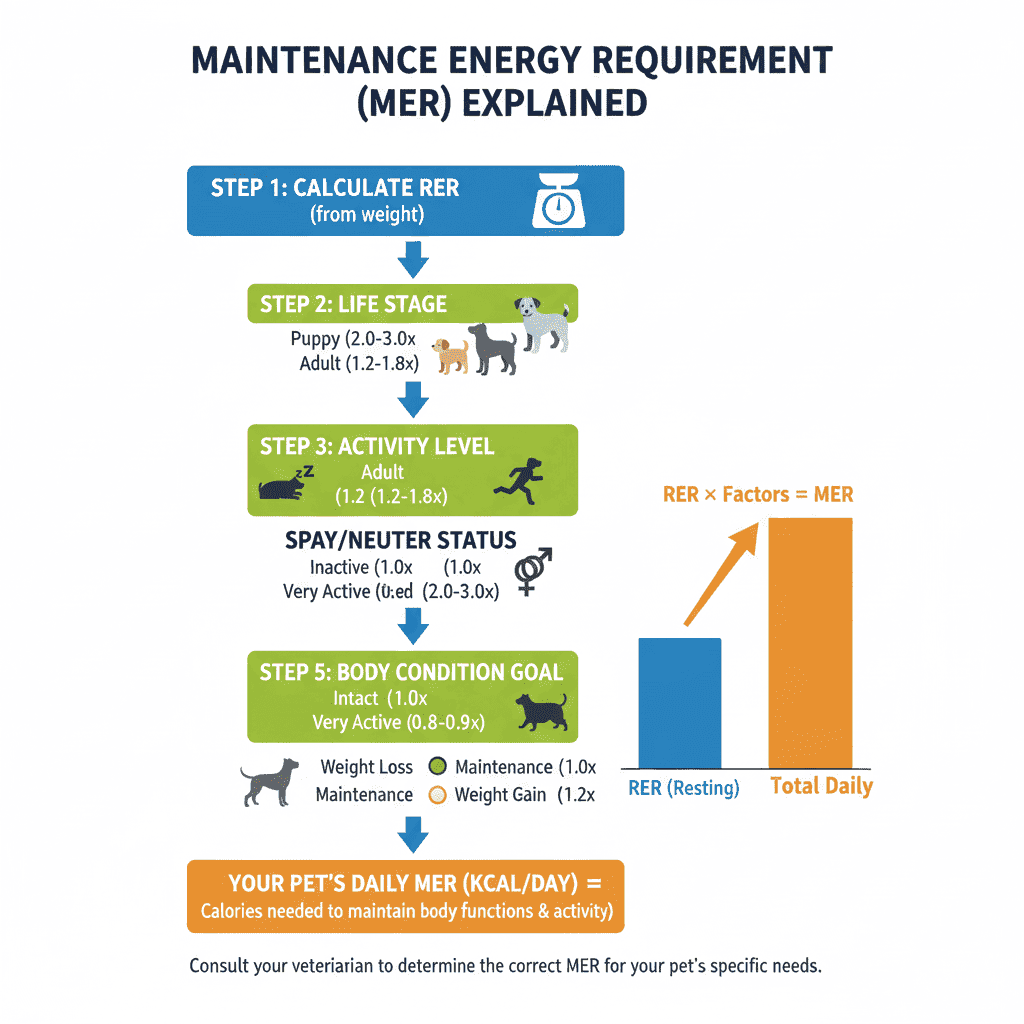Your dog's weight tells you something, but it doesn't tell you everything. Two dogs can weigh exactly the same but have completely different body compositions—one might be perfectly healthy while the other is dangerously overweight or underweight.
This is why veterinarians use Body Condition Score (BCS) instead of relying solely on the scale. BCS is a hands-on assessment method that evaluates your dog's body fat and muscle mass, giving you a clear picture of whether they're too thin, just right, or carrying excess weight.
The good news? You can learn to perform this assessment at home. With a little practice, you'll be able to monitor your dog's body condition between veterinary visits, catch weight issues early, and make informed decisions about their diet and exercise.
What You'll Need
- Your dog (standing calmly on a flat surface)
- Your hands (for feeling ribs and body shape)
- Good lighting (to see body contours)
- About 5 minutes of your time
- A quiet space where your dog feels comfortable

Step-by-Step: The Three-Point Check
The BCS assessment focuses on three key areas: the ribs, the waist, and the abdominal tuck. Here's how to evaluate each:
Step 1: Feel the Ribs
Position: Stand beside your dog and place both hands on their ribcage, one on each side.
What to do:
- Gently place your fingertips on the ribcage, just behind the front legs
- Apply light pressure (similar to feeling the back of your hand)
- Move your hands along the ribcage from front to back
What you're feeling for:
Ideal (BCS 4-5):
- Ribs are easily felt with light pressure
- You can count individual ribs
- There's a thin layer of fat covering the ribs (like a light blanket)
- Ribs are not visible, but you can feel them clearly
Too Thin (BCS 1-3):
- Ribs are very prominent and easily visible
- Little to no fat covering
- You can see individual ribs without touching
- Spine and hip bones are also very prominent
Overweight (BCS 6-7):
- Ribs are difficult to feel, requiring firm pressure
- Thick layer of fat covering the ribs
- You cannot count individual ribs
- May feel like pressing into a soft cushion
Obese (BCS 8-9):
- Ribs cannot be felt, even with firm pressure
- Very thick fat layer
- Ribcage feels like a solid, padded surface
- Fat deposits may be visible on the back and sides
Step 2: Check the Waist (View from Above)
Position: Stand directly above your dog, looking down at their back.
What to look for:
- Find the area just behind the ribs (where the "waist" would be)
- Look at the overall body shape from above
- Compare the width at the ribs to the width at the waist
What you're looking for:
Ideal (BCS 4-5):
- Clear, visible waistline behind the ribs
- Body has an hourglass shape when viewed from above
- The waist is noticeably narrower than the ribcage
- Smooth, gradual curve inward
Too Thin (BCS 1-3):
- Exaggerated, severe waistline
- Extreme hourglass shape (may look like a wasp waist)
- Waist is much narrower than the ribcage
- May appear concave or "pinched in"
Overweight (BCS 6-7):
- Waistline is barely visible or absent
- Body appears straight or rectangular from above
- Little to no narrowing behind the ribs
- May be wider at the waist than at the ribs
Obese (BCS 8-9):
- No waistline visible at all
- Body is oval or round from above
- May be significantly wider at the waist than at the ribs
- Back appears broad and flat
Step 3: Assess the Abdominal Tuck (View from the Side)
Position: Stand beside your dog and view them from the side at eye level.
What to observe:
- Look at the area between the ribcage and the hind legs
- Observe the curve of the belly
- Check where the lowest point of the abdomen is
What you're looking for:
Ideal (BCS 4-5):
- Clear abdominal tuck visible
- Belly curves upward from the ribcage toward the hips
- The lowest point of the abdomen is well above the bottom of the ribcage
- Smooth, upward curve
Too Thin (BCS 1-3):
- Extreme abdominal tuck
- Belly is severely tucked up
- Very pronounced upward curve
- May appear "tucked up like a greyhound"
Overweight (BCS 6-7):
- Reduced or absent abdominal tuck
- Belly hangs down or is straight
- Little to no upward curve
- Lowest point of abdomen may be at or below the bottom of the ribcage
Obese (BCS 8-9):
- No abdominal tuck at all
- Belly sags downward significantly
- May hang lower than the bottom of the ribcage
- Obvious "pot belly" appearance
Putting It All Together: Determining Your Dog's BCS
After checking all three areas, combine your findings:
BCS 1-3: Underweight
- Ribs, spine, and hip bones easily visible
- Extreme waist and abdominal tuck
- No body fat can be felt
- Action: Consult your veterinarian immediately. Your dog may have underlying health issues.
BCS 4-5: Ideal Weight (Perfect!)
- Ribs easily felt with light pressure (not visible)
- Clear waistline when viewed from above
- Visible abdominal tuck from the side
- Action: Maintain this condition! Your dog is at their ideal body composition.
BCS 6-7: Overweight
- Ribs difficult to feel, requiring firm pressure
- Waistline barely visible or absent
- Reduced or absent abdominal tuck
- Action: Begin a weight loss program. Reduce calories by 10-20% and increase exercise.
BCS 8-9: Obese
- Ribs cannot be felt, even with firm pressure
- No waistline visible
- No abdominal tuck; belly sags
- Action: Immediate veterinary consultation required. Your dog needs a structured weight loss plan.
Special Considerations for Different Dog Types
Long-Haired or Fluffy Dogs
For dogs with thick coats (like Golden Retrievers, Huskies, or Collies):
- Rely more on touch than sight - the coat can hide body shape
- Feel for ribs and body contours with your hands
- The waist and tuck may be less visible, so tactile assessment is crucial
- Consider checking during or after grooming when the coat is shorter
Short-Haired Dogs
For dogs with short coats (like Labradors, Boxers, or Beagles):
- Both visual and tactile assessment work well
- You may be able to see ribs if the dog is underweight
- Body contours are more visible
Deep-Chested Breeds
For breeds like Greyhounds, Whippets, or Dobermans:
- These dogs naturally have more visible ribs and a more pronounced tuck
- A BCS 4-5 may look leaner than in other breeds
- Focus on whether you can feel ribs easily (not whether they're visible)
Stocky or Heavily Muscled Breeds
For breeds like Bulldogs, Mastiffs, or Rottweilers:
- These dogs naturally have a stockier build
- Focus more on the waist and abdominal tuck
- Muscle mass can make ribs harder to feel even at ideal weight
- Look for the absence of excess fat deposits
Small Dogs
For toy and small breeds:
- Use gentle pressure when feeling ribs
- The assessment principles are the same, just on a smaller scale
- Be careful not to apply too much pressure
Large or Giant Breeds
For large and giant breeds:
- The assessment process is the same
- You may need to stand or kneel to get the right viewing angle
- Take your time to feel the entire ribcage
Common Mistakes to Avoid
-
Checking right after a meal: Your dog's belly will be full and may appear larger. Check when their stomach is empty.
-
Not using both hands: Use both hands to feel the ribcage for a complete picture.
-
Applying too much pressure: You should be able to feel ribs with light pressure. If you're pressing hard, your dog may be overweight.
-
Only checking from one angle: You need to check from above (waist) and from the side (abdominal tuck) to get the full picture.
-
Comparing to other dogs: Each dog has their own ideal body condition. Don't compare your dog to others.
-
Ignoring breed characteristics: Some breeds naturally look different. Know your breed's typical body type.
When to Check Your Dog's BCS
Regular monitoring:
- Monthly if your dog is on a weight management program
- Every 3 months if your dog is at ideal weight
- Weekly during active weight loss or gain programs
Special circumstances:
- After spaying or neutering (metabolism changes)
- After illness or surgery
- When activity level changes significantly
- During seasonal changes (some dogs are less active in winter)
- After diet changes
What to Do with Your Results
If Your Dog is Ideal Weight (BCS 4-5)
Congratulations! Your dog is at their ideal body condition. To maintain this:
- Continue with current feeding amounts
- Maintain regular exercise routine
- Reassess monthly to catch any changes early
- Adjust portions if activity level changes significantly
If Your Dog is Overweight (BCS 6-7)
Time for action:
- Consult your veterinarian to rule out medical causes
- Reduce calories by 10-20% from current intake
- Increase exercise gradually (don't overdo it initially)
- Reassess monthly to track progress
- Consider using a meal planner to calculate precise portions
If Your Dog is Obese (BCS 8-9)
Immediate action required:
- Schedule a veterinary visit - obesity can have serious health consequences
- Work with your vet to create a structured weight loss plan
- Reduce calories by 20-30% (under veterinary supervision)
- Start with low-impact exercise to avoid joint stress
- Monitor progress weekly initially
- Be patient - healthy weight loss takes time
If Your Dog is Underweight (BCS 1-3)
Veterinary consultation needed:
- See your veterinarian immediately - underweight can indicate serious health issues
- Rule out medical causes (parasites, disease, dental problems)
- Increase calories gradually under veterinary guidance
- Consider higher-calorie foods or supplements
- Monitor weekly until reaching ideal weight
Using BCS with Your Meal Planning
At PetMealPlanner, we use your dog's Body Condition Score to create personalized meal plans:
- Input your dog's BCS when setting up their profile
- Our system calculates the appropriate calorie target based on BCS
- Meal plans adjust automatically as your dog's BCS improves
- Track progress by updating BCS monthly
The more accurate your BCS assessment, the more precise your meal plan will be.
The Bottom Line
Learning to perform a Body Condition Score check at home puts you in control of your dog's health. It's a simple skill that takes just a few minutes but provides invaluable information about your dog's well-being.
Remember: The goal isn't perfection on the first try. With practice, you'll become more confident in your assessments. And always discuss your findings with your veterinarian—they can confirm your assessment and help you create a plan to achieve or maintain your dog's ideal body condition.
Ready to create a personalized meal plan based on your dog's body condition? Use our pet meal planner to get started, and don't forget to share your BCS findings with your veterinarian at your next visit.
For more information on Body Condition Scoring, see our comprehensive guide: Beyond the Scale: How to Use Body Condition Score (BCS).


